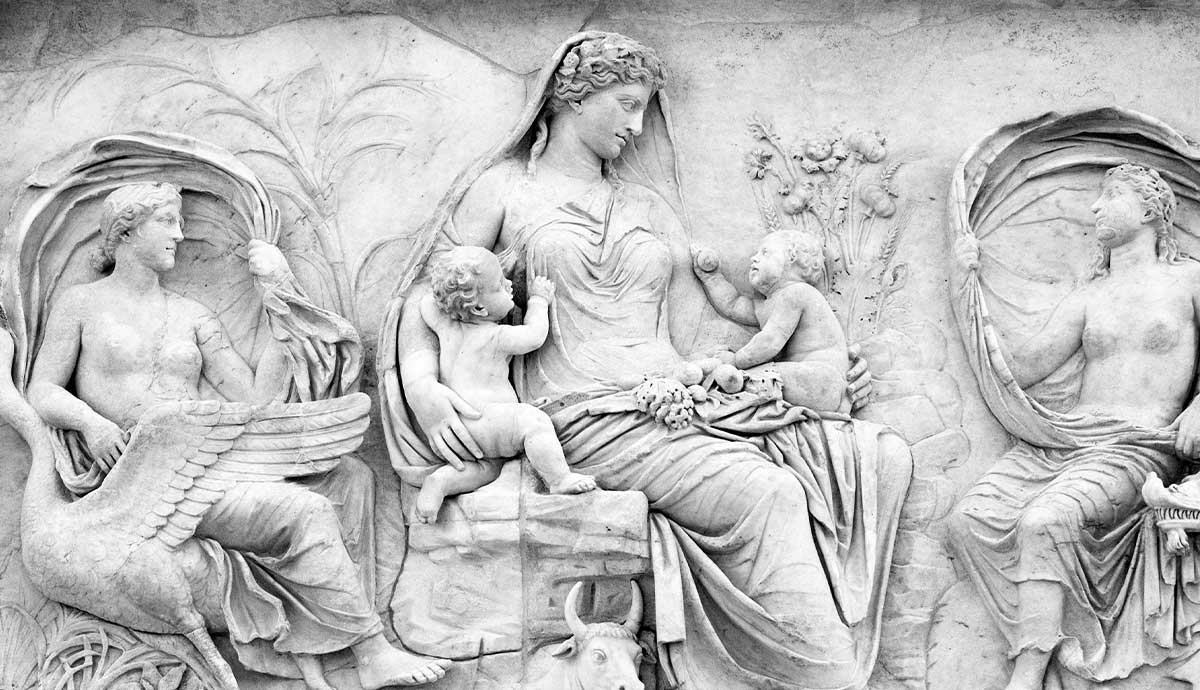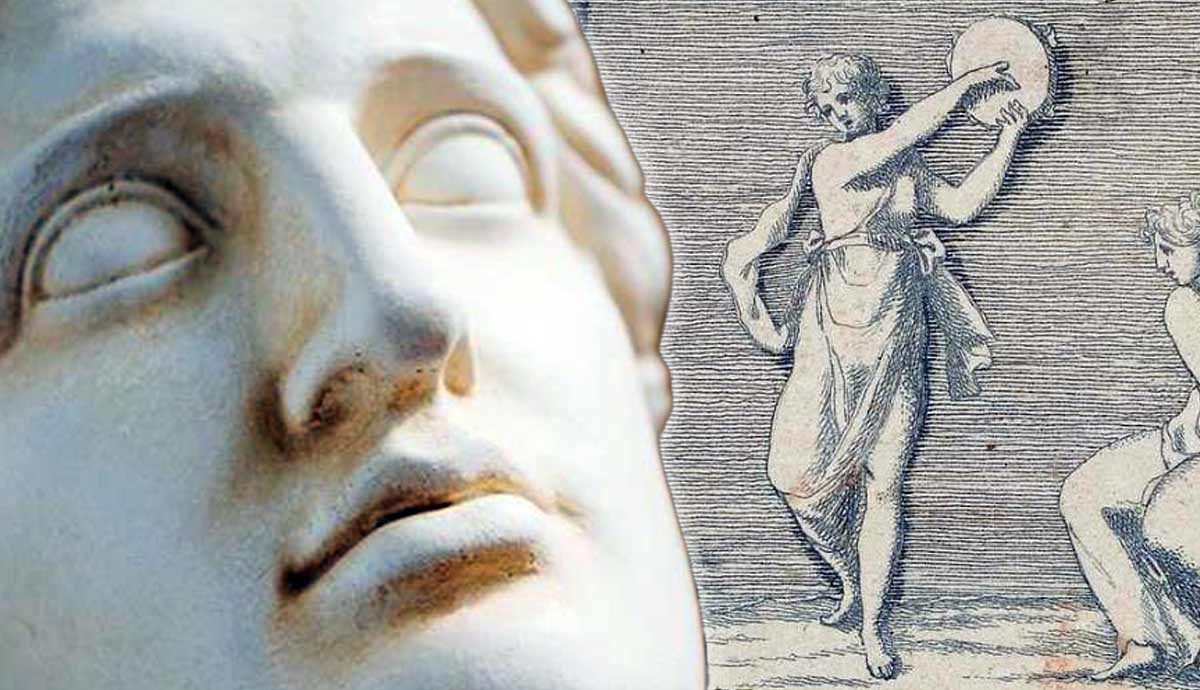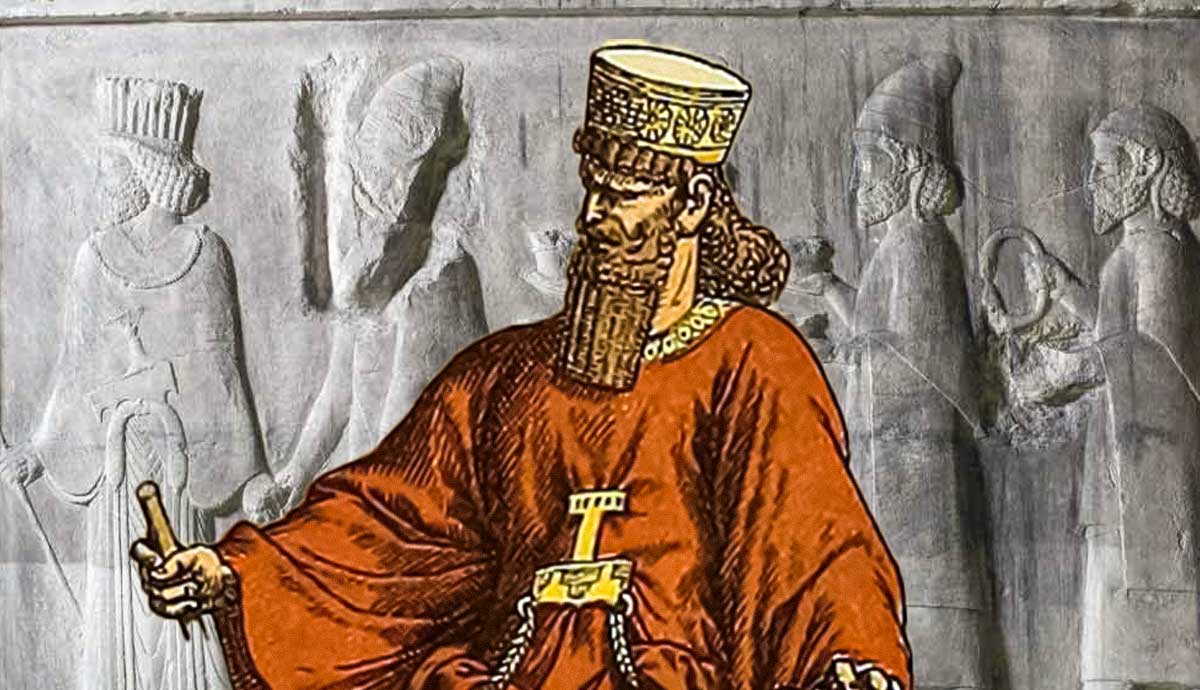
Rome’s first emperor Augustus erected the Ara Pacis, an altar dedicated to Pax Romana, in 13 BCE. It celebrated that Augustus had brought peace to Rome following years of war, and its dedication coincided with a period during which Augustus promoted the importance of family and fertility for the future of Rome.
By this time, Augustus’s family had become a royal family in all but name, and the lines between Augustus’s activities as a private individual and a state functionary had become blurred. He was now pater patriae, a title he would adopt in 2 BCE, the “father of the fatherland.”
Augustus used the Ara Pacis to visualize on a monumental scale what he believed to be the importance of family for the future of Rome, and the importance of his own family within the Roman state.
Ara Pacis: Dedication of the Altar

The Ara Pacis is a sacrificial altar that was dedicated for the purpose of conducting blood sacrifices as part of the Roman state religion. The Romans believed that for the state to thrive, the gods had to be respected as the patrons of Rome through blood sacrifice. They believed that failing to make sacrifices, or making them incorrectly, could lead to disaster.
In his Res Gestae, Augustus’s account of all his great deeds, Rome’s first emperor explains why the Senate voted him the altar. It is worth noting that while the altar was officially dedicated by the obedient Senate in 13 BCE, there is no question that Augustus was the mastermind behind the piece of propaganda consecrated on January 30, 9 BCE.
“When I returned from Spain and Gaul, in the consulship of Tiberius Nero and Publius Quintilius, after successful operation in those provinces, the Senate voted in honor of my return the consecration of an altar to Pax Augusta in the Campus Martius, and on this altar, it ordered the magistrates and priests and Vestal Virgins to make annual sacrifices” (II.12).
The altar is surrounded by a marble screen that is decorated with detailed high-relief scenes that were originally colorfully painted. The various scenes represent the core contributors to Pax Romana. It shows scenes from mythology that established Rome for greatness, and it places Augustus’s family very prominently on a public stage, suggesting that the prosperity of Rome depended on them.
That Rome’s prosperity is linked to Augustus himself is encapsulated in the dedication to Pax Augusta, the goddess that personifies peace as achieved through Augustus. Several other virtuous personifications were also linked to Augustus. The temple of Concordia in Rome was rebuilt and dedicated to Concordia Augusta in 10 CE. On coins we often see Victoria Augusta, Fortuna Augusta, Securitas Augusta, and more.
Altar Decorations

The altar itself sits on a stepped-based podium with a table placed on top, and decorated barriers on top of the table. On one side, the outward facing side of the barrier shows a sacrificial procession, with men in short tunics leading three animals to sacrifice. These have been identified as an ox, a bull, and a ram. The men carry a variety of sacrificial tools including a club, a knife, dishes, and pitchers. The scene is capped on either end with a winged lion griffin. The top of the barrier is decorated with what are known as vegetal scrolls, curling scrolls formed by depictions of plants.

The inner facing side of the same barrier shows a sacrificial procession with six Vestal Virgins flanked by male figures. These processions seem to reflect the sacrifices ordered by the Senate at the altar, as the Vestals were among the priests specifically listed.
The detailed procession scenes from the other barrier do not survive, but we know that it was decorated in a similar fashion from remnants of surviving figures. Overall, the altar seems to have been designed to be functional, with minimal decoration. This contrasts with the style of the walls of the precinct that was set up around the altar.

The upper register of the interior of the precinct walls are decorated with images of ox skulls, garlands, and other vegetal imagery, which represent abundance. The lower register imitates the appearance of traditional wooden altar precincts and was no doubt a tribute to these earlier altars.
Pax Relief

It is the exterior walls of the precinct, which would have been visible to the passing public, that have the most elaborate decoration. It is here that Augustus clearly communicated his vision.
The east side has a façade opening to enter the altar precinct and is decorated either side of the façade with an upper and lower register. All the lower registers on the outside of the precinct walls are decorated with vegetal scrolling and plant imagery. These regions would not have been highly visible among the passing crowds. The upper registers are another story.
The left side focuses on a seated woman in the garb of a goddess. Her identification is not certain. She may well be Pax, as she does not appear to be depicted elsewhere on the altar. But the scene clearly represents abundance, suggesting that she could be Roma, Italia, or Tellus, personifications of Rome, Italy, and the Earth. It has also been suggested that she represents Venus, the goddess that the Julio-Claudians claimed as their ancestor.

Whoever the goddess is, she sits on a rocky outcropping and gently encircles a child in each arm. An ox and a sheep are near her feet, and fruits lie in her lap. She is flanked by nymphs representing the beneficial winds of the earth and the sea. This goddess is clearly a symbol of fertility. This does not exclude her from being Pax, and peace brings abundance and fertility.
Not unlike modern states, Augustus was concerned about the decrease in fertility among the Roman people and passed morality laws, in 18 BCE and 9 BCE, designed to increase the population by encouraging marriage and baby-making. The law incentivized women to marry and have children by liberating women who had at least three children from the male guardianship to which they were usually subject. They also had the right to inherit from their own children. People who stubbornly refused to marry were restricted from inheriting.
Roma Relief

The relief on the right side of the façade is almost completely lost. Nevertheless, it is speculated that it depicted the Roma. All that survives is the lap of a seated figure, draped in fabric, and part of a shield. Based on these tiny details, it has been suggested that the goddess is Roma, as she was often shown enthroned on a shield and other weapons on Roman coinage starting from the 1st century BCE.

Roma became an important figure in Roman religion as the Roman Empire expanded. The people of many new Roman provinces, especially in the east, were accustomed to paying cultic homage to conquering kings, but Rome had none. These provincials were known to offer cults to individual magistrates, but these were always short-lived as officials changed regularly. But this all changed with Augustus.
The province of Asia requested permission to dedicate a temple to Augustus in 29 BCE. The princeps, wanting to at least appear humble to those watching in Rome, accepted the temple only if it was in combination with the goddess Roma. This set a precedent, and similar temples of Roma and Augustus popped up all over the empire.
While this was acceptable in the provinces, Augustus would not have depicted himself alongside Roma on an altar in the heart of Rome. It is unclear what imagery flanked Roma on the Ara Pacis relief, if it even is a relief of Roma.
Lupercal Relief

On the west side there is another façade entrance to the precinct with reliefs on either side. The relief on the left side is known as the Lupercal relief because the fragmentary relief is believed to show the shepherd Faustulus discovering the infants Romulus and Remus suckling from a she-wolf at the entrance to a wolf cave, a Lupercal, while Mars, their divine father, looks on.
This reconstruction is based on minimal surviving portions of the relief. All that survives of the shepherd is a portion of his arm and hip alongside a small portion of a fig tree. The head of the god Mars also survives, identified by his plumed helmet. The reconstruction is based on other Lupercal scenes, such as on the Trajanic altar below.

This scene refers to the legendary foundation of Rome and points to the continuity and divine favor of the city. The twin boys Romulus and Remus were the sons of the Alban princess and Vestal Virgin Rhea Silva by the god Mars. Through their mother, the boys were the descendants of the Trojan hero Aeneas and various Italian kings. The boys were born after their grandfather’s throne was usurped by his brother, and when they were born, the new king ordered the pair thrown in the Tiber River. The men sent to do the job simply left them on the side of the river to die. But instead, they were found by a she-wolf who suckled them until a shepherd, Faustulus, who knew who the boys were, found them and adopted them.
When the boys grew up, they avenged their grandfather, restored his throne, and then decided to establish their own city. Remus was killed in a conflict between the two about where to locate the city, but Rome was established, and Romulus elected its first king. He also made the first sacrifices to Jupiter and other gods to bring divine fortune to the city.
The presence of Mars in the scene also suggests that peace is won through war and was probably meant to recall the Augustan campaigns that were responsible for the current peace. This would have been a powerful message for many Romans who had lived through decades of civil wars.
Aeneas Relief

On the right side of the façade is what is known as the Aeneas relief. It shows a man in priestly garb and two young attendants preparing to sacrifice a pig, which was a common sacrificial victim when Rome made peace treaties.
Some scholars suggest that the priestly figure is meant to be the Trojan hero Aeneas, who made his way to Italy after the sack of Troy. According to the Roman poet Virgil, when he arrived, he sacrificed a sow and 30 piglets to the goddess Juno. Aeneas is not only meant to be an ancestor of Romulus but was also claimed as an ancestor of Augustus. It was through Aeneas, reportedly the son of Venus, that the Julio gens also claimed descent from the goddess. We know that this is a legend that Augustus himself promoted because it features heavily in Virgil’s epic poem about Aeneas, The Aeneid, written under Augustan patronage between 30-19 BCE. Virgil implies that it was Aeneas’s destiny to begin the civilization that would become Rome, and that Augustus is fulfilling his ancestor’s divine mission.
However, nothing in the surviving scene verifies that the priestly figure is Aeneas, although it would make sense within the context of Augustan ideology. An alternative suggestion is that it is Rome’s second king, Numa Pompilius, who is credited with establishing most of the religious traditions, including priesthoods and sacrifices, that the Romans relied on for their positive relationship with the gods. He also built the temple of Janus, which was associated with peace. The temple doors were only closed when Rome was at peace and were said to be closed throughout Pompilius’s reign. In his Res Gestae, Augustus included how many times he was able to close the doors of the temple of Janus.
Procession Reliefs

The two other sides of the enclosure have no entrance facades and therefore have long upper panel reliefs. Augustus utilized these to show a larger-than-life religious procession of the sort that would have occurred on important sacrificial days. It has been argued that the procession depicted represents a specific sacrifice, probably a thanksgiving ceremony for Augustus’s victories held in 13 BCE, the same year the altar was originally dedicated.
The procession on the south side is marked by two prominent figures wearing togas. They have facial features recognizable from other portraits, and have been identified as Augustus and Agrippa, Augustus’s right-hand-man in power until he died in 12 BCE.

Augustus is the first semi-complete figure visible in the procession, though half of his body is missing. He wears a laurel crown, which was a symbol of victory. While Augustus is also wearing priestly garb, he is not shown as the Pontifex Maximus, the chief priest of Rome, as he would not assume that position until 12 BCE. He had to wait for the incumbent, his now exiled former ally Marcus Aemilius Lepidus, to die.
Augustus is preceded by a group of lictores, who carried the fasces representing the imperium and authority of Augustus and acted as his bodyguard. The fact that they are looking in various directions and not following the procession suggests that they are active in this capacity.
Looking at the prominent figures in the foreground, rather than the crowd in the background, Augustus is followed in the procession by the two consuls and four men in spiked caps, who are flamines maoires. There were traditionally three flamines maoires, who served the cults of Jupiter, Mars, and Quirinus. This procession depicts four, and the fourth was probably the priests of Divus Julius, created when Augustus had his adoptive father Julius Caesar deified in 42 BCE. After them comes an attendant with an ax, used to dispatch the sacrificial victims.

Behind the flamines is another figure who has been carved to be very prominent and has his head covered. This is Agrippa. His attire suggests that he was acting as high priest, with Lepidus in exile.
The figure to the right of Agrippa is probably Livia, Augustus’s popular and powerful wife. Between them is a small boy. It has been suggested that he is a Germanic prince, living in Rome as a hostage, because he wears no toga. Behind Livia is presumably her son Tiberius, Augustus’s stepson who would be the next Roman emperor. Behind him is probably Antonia the Younger, the daughter of Mark Antony and Augustus’s sister Octavia.
Behind Octavia are Drusus, her husband and Tiberius’s brother. Between them we can see their young son, who would become the famous general Germanicus. They are followed by Antonia the Elder, another daughter of Antony and Octavia, and by her husband Lucius Domitius Ahenobarbus. The children between them are probably their son and daughter. Their son, Gnaeus Domitius Ahenobarbus, would go on to be the biological father of the emperor Nero.

While the north side does not feature Augustus, it features a similar combination of priests and family members.
In the fragmentary section at the start of the procession, where a few children are visible, it is assumed that this section featured Augustus’s daughter Julia and her sons Gaius and Lucius Caesar, who would be Augustus’s heirs until their untimely deaths in 4 CE and 2 CE respectively. Augustus’s sister Octavia probably also appears.
It is difficult to identify many of the figures on this side as many of the heads are not original. We can identify priests of the college of quindecemviri, who were the guardians of the sacred Sybilline books, and the septemviri, who were responsible for preparing religious feasts, and more lictores.
Understanding the Ara Pacis Augustae

While we cannot identify all the people in the procession scenes that appear on the Ara Pacis, the meaning is still clear. The mixing of the men, women, and children of Augustus’s family, and the mixing of Augustus’s theoretically private family with public officials, were both unprecedented.
The number of women and children probably relates back to Augustus’s moral legislation that promoted fertility. Augustus was clearly showing that his family practiced what he preached.
The blurring of the lines between public officials and Augustus’s private household shows how closely the prosperity of the Roman state and the prosperity of Augustus and his household were believed to have become. Just as the Romans needed the favor of the state gods, such as Jupiter and Mars, to thrive, they also needed Augustus’s household to thrive.









